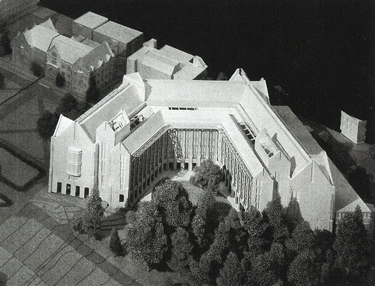UW faces $32 million cut while tuition, enrollments increase

The state budget includes $90 million to build a new Electrical Engineering/Computer Science Building northwest of the present Electrical Engineering Building facing Frosh Pond.
The University of Washington must absorb a $32-million shortfall in state funding following the passage of the 1993-95 state operating budget in an early morning session May 6.
Facing a $1.8 billion state deficit over the next two years, Gov. Mike Lowry and legislators slashed spending by $700 million and raised about $668 million in new taxes.
The budget earmarks $685 million to cover UW operations over the next two years. That number includes a 4.6 percent cut in the amount it would take to continue operating at current levels—which means a $32 million loss in operating revenue.
“While cuts of this magnitude will be difficult to make and will have some very regrettable consequences on campus, we understand the problems legislators and the governor are facing. We appreciate their efforts to try to contain the cuts to the University and higher education,” says President William P. Gerberding.
Rather than an across-the board reduction, the UW wants to protect as much as possible the improvements made in the late 1980s in undergraduate education.
Decisions have been made which allocate cuts ranging from 3 to 7 percent to all campus units. Vice presidents, deans and the director of the libraries will decide over the next weeks how to allocate the cuts within their units or areas of responsibility.
“Our approach to the budget cuts is primarily to bring the allocation of state resources into better alignment with the teaching and student services responsibilities of the various units,” says Provost Laurel Wilkening.
Legislators turned to higher tuition to help keep the cuts from bleeding state institutions. Lawmakers raised in-state, undergraduate tuition more than 12 percent this fall and another 15 percent in the fall of 1994, a rise of 29 percent over the two years.
Currently the rate is $2,253. In September students will pay $2,532 and in the fall of 1994 they will pay $2,907. The increase means that students will cover 41 percent of the cost of their education, up from the current 33 percent.
To help absorb the impact of the tuition hike, the legislature poured $52.6 million into the state financial aid system, which will allow students from families with incomes up to $27,000 to get state aid. Legislative staff estimate that an additional 18,000 students will qualify. However, the way the state financial aid program is handled, it is estimated that the 10,000 UW students already receiving aid will pay $15 to $16 million more for tuition but will get only $3.4 million more for financial aid.
Though it was a tight budget year, state legislators felt increasing pressure to raise enrollment lids at state universities. However, at the UW and WSU main campuses, they funded only 70 percent of the true cost of adding new students.
UW campuses will have to make space for the equivalent of 464 fulltime students. The main campus will have 160 spaces for graduate students and 150 for the undergraduate evening degree program. The Tacoma campus will get 100 spaces, allowing it to begin business and physician’s assistant degree programs. The Bothell campus will have 54 new spaces to begin a new business degree program.
Looking over the entire session, UW Government Relations Director Bob Edie feels the cuts could have been much worse. “If the reductions had remained at the governor’s level (approximately $46 million), it would have been much harder to maintain enrollment levels, preserve most faculty and staff positions and protect the improvements of the late 1980s. The legislature did a good job in a very difficult year.”
On the capital side of the balance sheet, UW officials are pleased with the $200 million the state has set aside for new construction and renovations. Capital budgets are funded by bond revenue, not direct tax dollars. “This is a very good capital budget no matter how you look at it,” comments Edie.
At the top of the UW list is $90 million for a new Electrical Engineering/Computer Science Building to go up behind the current Electrical Engineering Building. The building—which will be the most expensive state-funded structure on campus—will have 295,000 gross square feet of new and renovated space housed in a brick edifice in tune with the UW’s Collegiate Gothic style. About 100,000 square feet of the existing Electrical Engineering Building will be torn down to make way for the new structure.
Also included in the 1993-95 capital budget is $32.5 million to renovate the old Physics Building, once the new Physics/ Astronomy Building opens in the summer of 1994. The state also provided $6.8 million for a new business library, auditorium and executive center to be built north of Balmer Hall. About $7.5 million in private funds will match the state revenue.
UW-Tacoma received about $31 million to begin its first phase of construction at its downtown site near Union Station. The UW plans to either renovate or construct eight buildings for classrooms, laboratories, offices and a library.
UW-Bothell received $23 million, which is not enough to fully fund the first phase of construction at its Wellington Hills Golf Course site in Bothell: The money will be used for infrastructure, utility work and a start on construction.